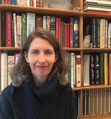Lory Widmer Hess's Blog, page 8
March 31, 2024
New Newsletter: Healing Stories and Sacred Songs on Substack
In my blog newsletter, The Enchanted Circle, I’ve been featuring links to works by other writers that I’ve found online. There is so much wonderful stuff out there, and I enjoy pointing readers to some of my favorite discoveries.
I’ve now decided to split this off into its own newsletter on Substack. It will be called Healing Stories and Sacred Songs and will feature a work of prose and poetry in each post, plus a quote from a book I recommend. I focus on themes of healing as a process of coming to wholeness, and finding the sacred in everyday life.
Readers are welcome to nominate poetry and prose they think could be included — including their own work.
You can check it out here:
Healing Stories and Sacred Songs on SubstackOr if you’re ready to sign up, use this form:
This offering is and will always be free. I hope you’ll take a look, and help to spread the news.

March 26, 2024
April is almost here, and Reading the Theatre will be back!
A few years ago, during the pandemic when attending performances in person was not possible, I decided to celebrate spring with a month of “Reading the Theatre”–all kinds of theatre-and-music-related fiction and nonfiction, along with reading plays and watching films or videos.
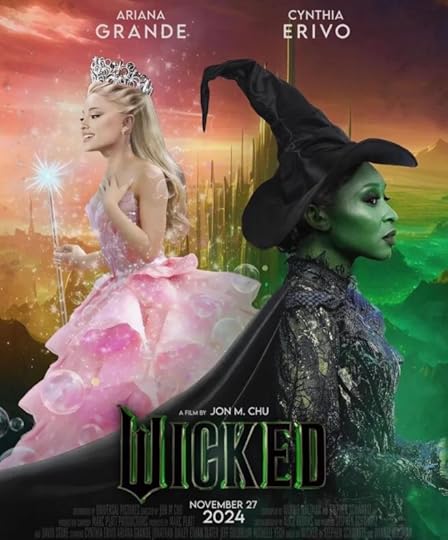
Even though not many have chosen to join in with the project, I really enjoy doing it and have looked forward to this time all year. April seems an appropriate month, with Shakespeare’s birthday and all.
For 2024, as my Ozathon readalong project continues, I intend to reread Gregory Maguire’s novel as well as a book about the production.
I saw the show on Broadway years ago and wasn’t that enamored of it, but I’m still interested to know what went into its creation. And a long-awaited film version is due to come out in the fall, apparently part I of II — a daring choice, as if the first part flops the second is unlikely to be made…
Other than that, I’m going to let serendipity be my guide, as it usually leads me to some wonderful surprises.
What would you recommend to read or watch for a month of Reading the Theatre?
 Photo by Pixabay on Pexels.com
Photo by Pixabay on Pexels.com
March 24, 2024
#Ozathon24: An Infernal Adventure
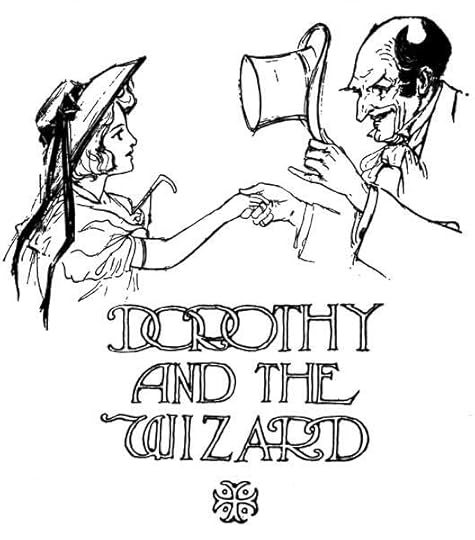
In Dorothy and the Wizard in Oz, the fourth Oz book, Dorothy, who has twice arrived in magical lands through natural disaster (a cyclone and a shipwreck) is sent tumbling underground by a California earthquake. Her companions this time are a farmhand named Zeb, and a cab-horse, Jim, who were conveying the girl to meet her Uncle Henry at the time — along with a new animal friend, the kitten Eureka. As the group journeys through underground regions, they meet many strange and dangerous beings while trying to get back to the surface. A less threatening, but equally improbable encounter is with the former Wizard of Oz, who happens to have been caught by the earthquake too.
Baum constantly contradicted and revised what he’d set up in former books as he went along. In The Wonderful Wizard of Oz, the wizard was portrayed ironically as an example of how people gladly fall in with deception if it gives them something they need, or think they need. In The Marvelous Land of Oz, his backstory grew even worse, a dastardly usurper who robbed a young princess of her throne and handed her over to an abusive guardian.
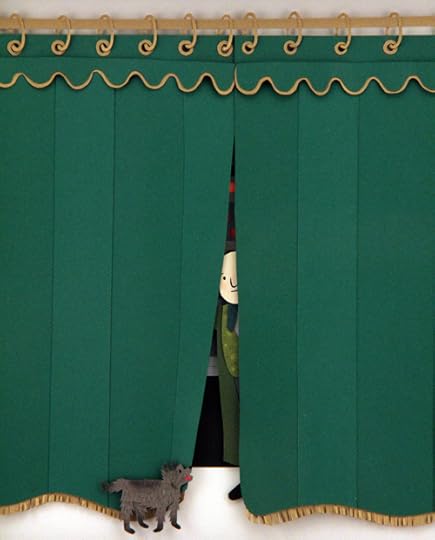 “The Man Behind the Curtain” by Jared Andrew Schorr
“The Man Behind the Curtain” by Jared Andrew SchorrIn this book, gone is the coward who hid behind a threatening image and had to be unmasked by a dog and a little girl. This wizard, while still a bit of a charlatan, can also be brave and resourceful, and he deceives in order to save others, not just himself. When he makes it back to Oz, he’s received as a beloved former ruler, well-known to his people (in the first book, hardly anybody had ever seen him). The little episode of his stealing Princess Ozma has been forgotten by all, including him.
His gifts to the Scarecrow and Tin Woodman appear to be morphing into something like real brains and a real heart, instead of the make-believe that played upon their gullibility and lack of self-knowledge. Even the Emerald City is now really covered in emeralds, instead of its universal green being a trick caused by the Wizard’s requiring everyone entering it to wear green glasses.
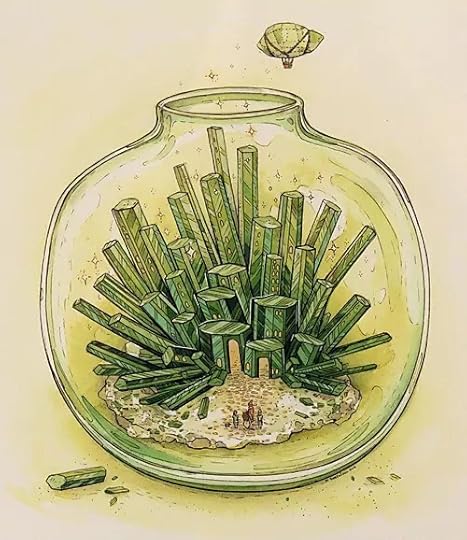 “The Emerald City” by Nicole Gustavsson
“The Emerald City” by Nicole GustavssonWhen I read the series as a child, these shifts bothered me not at all. I suppose I took each book on its own terms, and accepted changes as part of the general theme of magical transformation and shifting reality that pervades the books. Baum didn’t have a series in mind when he wrote the first books, but was pushed into one by their popularity. Some alterations were pure carelessness, others were made consciously to suit what he himself wanted to emphasize, or to meet children’s requests. As readers wanted the Wizard to be brought back, he chose to rehabilitate him rather than develop him into a thoroughgoing villain.
In spite of containing a less morally questionable Wizard, this is the darkest of the books so far. Did that reflect Baum’s underlying reluctance to write more Oz books, even as he signed a contract to complete a total of six? Certainly, this book takes a long time to get to Oz — an unnecessarily long time, given the deus ex machina device that saves the group when Dorothy finally remembers about it!
Instead of exploring Oz, we’re mostly stuck underground with nasty vegetable people, invisible bears, horrid gargoyles, and rapacious dragons, in episodes which, though imaginative and exciting, lack the humor, wonder, and even the friendly comradeship that mark the earlier adventures. Zeb and Jim are both fish-out-of-water characters who don’t belong in a magical land and just want to be sent back to California — in contrast to the magnificent Bill(ina) from the previous book, Ozma of Oz, whom we find happily settled in her new home when we arrive in the Emerald City at last.
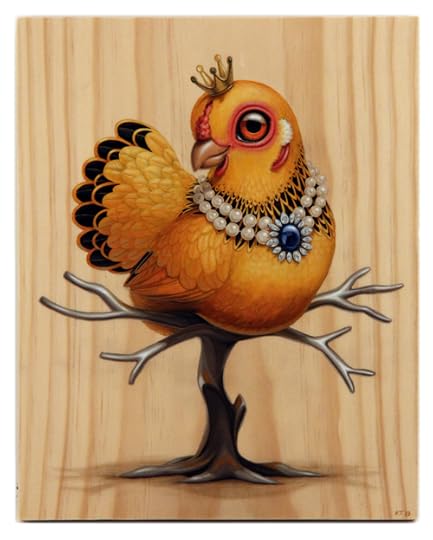 “Billina” by Cuddly Rigor Mortis
“Billina” by Cuddly Rigor MortisThere are still dangers to be faced once the party makes it to Oz Jim is cruelly humiliated by the untiring Sawhorse, and Eureka put on trial as a murderer — which it turns out she wasn’t, though not for lack of trying. The Ozites in attendance at the trial find it a fine source of entertainment, even though it didn’t end in a death sentence.
This trial scene seems to owe something to Alice in Wonderland, and the underground setting and morbid humor als remind me of Carroll’s book. Jules Verne’s Journey to the Center of the Earth was another likely inspiration, maybe even Dante’s Inferno.
In all, this is not the most typical Oz book, more nightmarish than most, and certainly not the most amusing. First-time readers may be daunted and unsure if they want to continue. I’d encourage them to keep going — there are better times ahead.
Images are by John R. Neill and from the Gallery Nucleus exhibition “Not in Kansas Anymore”
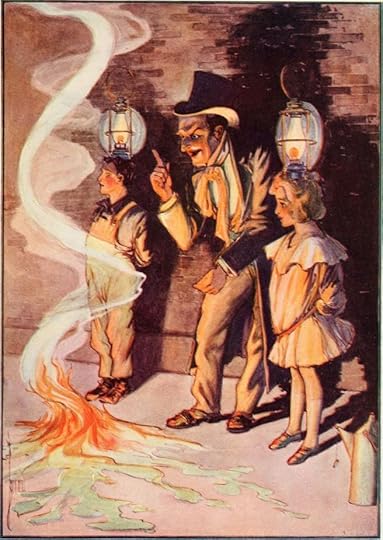 The Wizard’s tricks save the children from the menacing Mangaboos
The Wizard’s tricks save the children from the menacing Mangaboos
March 21, 2024
#MarchMagics2024: Talking about Diana Wynne Jones and the magic of writing
There’s nothing more satisfying for a booklover who happens to have offspring than to find them growing up to love the same kind of books. And so when my son chose to do a school project on Diana Wynne Jones, it felt as though one part at least of my task on earth had been completed.
What’s more, as he was supposed to interview someone as part of the assignment, he decided to talk to me! (While I’m honored by the compliment, I think this was also largely a matter of convenience.) And the timing was just right to post the interview as part of March Magics, the celebration of Diana Wynne Jones and Terry Pratchett currently taking place over at Calmgrove.
It was lovely to get to talk about one of my favorite authors, and one of my favorite activities, writing, with one of my favorite people. And now, we are happy to share it with you. Here you go…
Brendan Widmer: What can you say about your experience with Diana Wynne Jones’ work?
Lory Hess: Well, I first heard of her when I wrote a letter to my favorite author at the time, who was Robin McKinley, and I asked her to tell me what were her favorite books, and she said she loved Diana Wynne Jones, and (Diana) had just published a book called Fire and Hemlock, which (Robin) thought was brilliant.
BW: When did she publish Fire and Hemlock?
LH: 1986, I believe.
BW: So you were studying?
LH: I was in high school. And then I was in the bookstore and I saw a paperback of her book Charmed Life, which had a quote in it by Robin McKinley, and I thought “Aha! I’ll buy this.” And this was before the internet, where you could get books easily online, before Ebooks, so it was very exciting to find a book you wanted in the bookstore. And that’s how I started reading her.
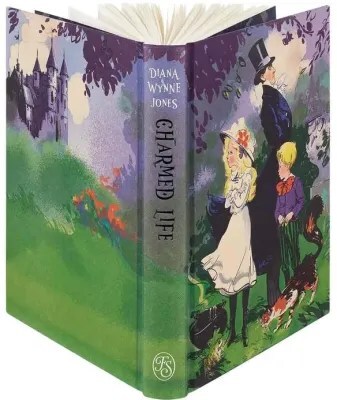
BW: And so what do you really like about Diana?
LH: Well, I like that she’s really imaginative, and funny and has kind of wild, interesting ideas that nobody else would come up with, but her books are also really about people, and relationships, and growing up, and finding your power. Often (they are) about children or young people who need to find their way. They need to fight these various evil magic forces, but it’s really all about them finding their own power of imagination or their own moral center or changing their relationships. I like that they have a certain amount of depth, but at the same time they’re entertaining and hilarious and they go by in a flash.
I also enjoy sharing her with people a lot, so I shared her with members of my family, with my husband and with you; I’m very happy that you have discovered this interest. When I was teaching, I read Witch Week to my class. Reading books was always my favorite part of teaching, and I think the kids liked it the most too.
BW: Yes, my teacher also read aloud to us, but she never read DWJ.
LH: I also found that in my blogging hobby, I enjoy connecting with other people who like her, and we exchange reviews and comment on each others posts, and we just enjoy spreading the love.
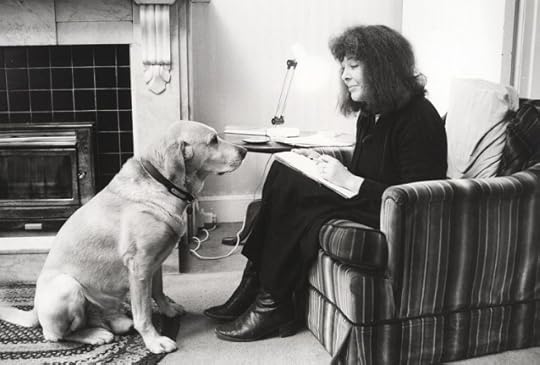 Diana Wynne Jones and Caspian
Diana Wynne Jones and Caspian
BW: So what’s your favorite book?
LH: I don’t like to pick a favorite, but I think that Fire and Hemlock is her masterpiece; it’s so good in so many ways and also I think brings up themes that she had’t written about up until that time. This was one of her mid period books.
BW: I was never quite sure what Polly’s relationship in that book was with Tom: did they end up being lovers, or were they just friends.
LH: When she was older….
BW: But at the beginning he seemed to be an old man.
LH: That was because she was because she was much younger, and I think he had blond hair, and he was also worn out with his fight with Laurel, so he looked old to her. But he wasn’t actually that old, maybe ten years older.
BW: Yes, that is a touching turn of events.
And I found it very hard to picture that scene in the water basin, or the fountain.
LH: I know, that was a confusing scene. Everyone says that: “What happened at the end?”
BW: And with the horse coming, and his cello, whatever he was doing with his cello.
LH: Yeah, well, it’s kind of like whatever strength you have will get used against you, so when he summoned those things they were coming at him, they were going to crash into him, so the only way Polly could save him would be to give him up completely. Because he depended on her to save him, but that meant that she could be used against him. And so she had to say “I never want to see you again.”
BW: But if she didn’t mean it, how does that work?
LH: She did mean it. She had to mean it.
BW: Well that must be difficult to do.
LH: It was.
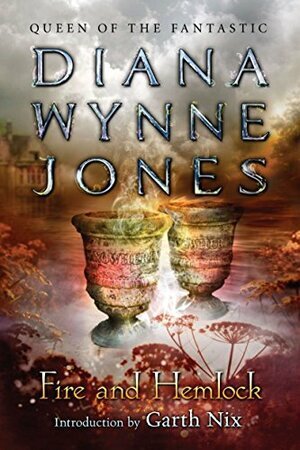
BW: I agree, that’s a very good book. But I also agree that I can’t single out any single books that are my favorite. I really like Charmed Life, and I really like Stealer of Souls, but they’re both totally different.
LH: That’s the thing, she doesn’t keep writing the same book over and over like some authors.
BW: J.K.Rowling, for example.
LH: Not to mention any names…
BW: Did you write anything to Diana Wynne Jones?
LH: I did.
BW: And did she reply?
LH: Yes.
BW: Oh cool, and what did she say?
LH: I was asking her about the Dalemark books, because at that time there only three, and there were supposed to be a fourth one, but I wanted to know if it would ever be published. And she said yes, she was working on it and it would come out eventually. It wasn’t a very long letter. Oh, and I also told her how I recommend her books to everybody and she said thank you for being such a distributor of my books.
BW: Well [when reading about DWJ’s childhood] I was quite disappointed to find out that Beatrix Potter was rather–well, she hated children, apparently.
LH: Yes, that’s not the image you have of Beatrix Potter.
BW: But why did she write books for children in the first place?
LH: I think she had nieces or something, you know, she had relatives and she liked them, but she didn’t like random children coming across her land. And when she got famous, people would come and try to see her house, and she probably was annoyed by that, because she wanted to be a farmer.
 Beatrix Potter’s Hill Top Farm
Beatrix Potter’s Hill Top FarmBW: In The Wand in The Word, Diana says she doesn’t research specifically for a book, researching rather much broader, and then letting it all simmer at the bottom of her mind until it comes up as a book. And she says she can feel the chunks falling into place when she’s really going.
So what would you say your creative process is?
LH: Well, I don’t usually write fiction, so the process is a little bit different.
BW: You write poetry.
LH: Right, so with that, there’s been thinking or observing, or some kind of experience, and then I get an idea and then, yes, I would agree that it’s kind of like a seed that grows from there, and might have to be adjusted of revised later, but usually the original seed still is there. And yes, that about chunks falling into place, that’s kind of how it works.
BW: And what gave you the idea to write your autobiography based on the stories of healing in the bible?
LH: Well, I didn’t set out to do that in the beginning, what happened was I had these poems based on the stories of healing in the Gospels, and I didn’t start out with all of them, I started out with three. That was the three people who were raised from the dead. So I studied these three stories one year, because I was having a hard time in my life, and I ended up writing poems about them. Then some years later I had the idea to write some more. So I ended up going through all the stories, and I just would read the story and sort of think about it and imagine it, and an idea would come.
BW: Are they all free verse?
LH: They’re all free verse, yes.
And then the book came about because I had this bunch of poems, and I thought wow, these are not bad, and maybe I could share them, and they might help other people, because they helped me get through a hard time.
BW: And so did you connect the poems with the happenings in your life?
LH: Right, so then what I did was I had the idea that each poem would have an essay that would be about the background and the thoughts going into it, and a piece from my own life. First, I actually wrote a whole memoir for myself, that I couldn’t publish for personal reasons, separately from the poem project. But then I thought, well, I can’t publish all of this, but maybe I can take parts from it and put them with the healing stories and it turned out they fit together quite well.
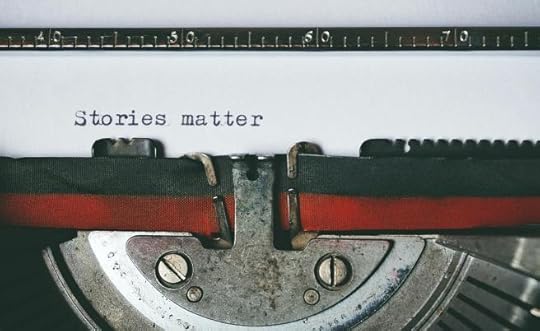 Photo by Suzy Hazelwood on Pexels.com
Photo by Suzy Hazelwood on Pexels.com
BW: Do you plan to write any fiction in the future?
LH: I might try again in the future. I always find that when I write fiction it never feels real, it just feels like I’m making things up. But I might try again someday.
BW: So you’ve tried once?
LH: Yes, I’ve tried to write stories.
BW: So what was the experience there?
LH: As I said, I can kind of come up with something but it doesn’t really satisfy me. I also feel like my imagination isn’t so strong. Some people can just imagine things that they haven’t even experienced, or their imagination transforms into these imaginative scenes.
BW: Well, it’s good that you know what you’re not satisfied with when it comes to writing.
LH: I wanted to be a writer since I was young, and I thought that meant I wanted to write fantasy novels like Robin McKinley and DWJ, and when I couldn’t, and it didn’t seem to come out, I thought I couldn’t be a writer. So what I’m glad about is that finally I could write something else.
BW: That’s great.
Well, it’s been nice talking to you. This has been a great talk. Even for your son it’s been educational.
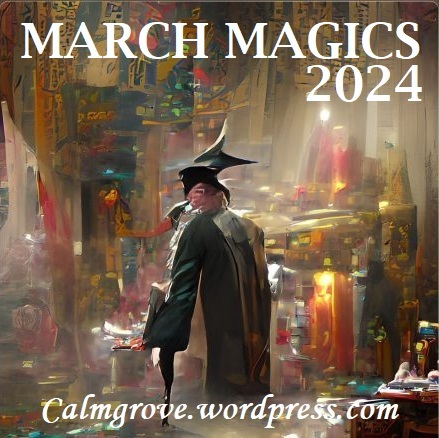
March 16, 2024
Nonfiction Reader Challenge: Circle of Hope
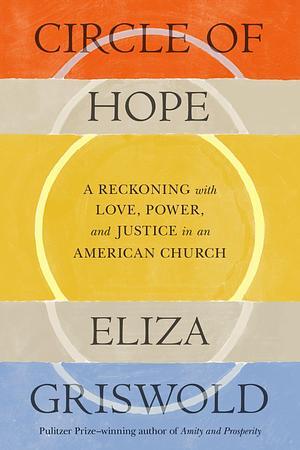
For the Nonfiction Reader Challenge category of a book published in 2024, I sampled a number of forthcoming releases, but for some reason this was the only one that caught my attention and made me want to read further. It’s a fairly up-to-the-minute story, too; it won’t be published till August, and the main action covers the last few years, up to Easter of 2023. The pandemic thus plays a key role, though one unexpected by the author when she started the project in 2019.
The subject is a Philadelphia church called Circle of Hope, which up to that point had been a remarkable growth story, at its height comprising over 700 members spread among four congregations. The founder, a “Jesus freak” from the 60s, was heading toward retirement, facing the challenge of handing his creation over to the next generation. The church had become an important source of local services and community building;. While aiming to uphold the values of the early Christians, to share resources and empower the disenfranchised, through enterprises including two successful thrift stores, it had quietly amassed $1 million in assets. An offshoot of the Anabaptist movement that emphasized the priesthood of all believers, it eschewed old traditions in favor of creative engagement with the way of following Jesus, with “love” as the watchword.
Sounds great, but there was trouble ahead. As the church was grappling with “Founder’s Syndrome” (as many organizations do when transitioning away from the influence of a strong leader), the pandemic hit with its burden of anxiety, raising controversy about how to keep people safe while still remaining a community. A legacy of racism was unearthed, and longtime resistance to affirming LGBTQ individuals surfaced as well. In an enclave of well-meaning, idealistic, liberal people, some uncomfortable truths had to be faced, including the fact that the percentage of BIPOC church members was significantly lower than in the city as a whole. As educated white people joined the church and moved into low-rent neighborhoods, they were driving out the former residents, and though they might think what they were doing was opposing capitalism, in fact they were enabling gentrification.
Griswold, the daughter of an Episcopal presiding bishop who found his own denomination deeply riven over LGBTQ affirmation, seems to have been drawn to the church out of interest in its liberal values, but found herself chronicling its demise. Over the course of just a few years, which the pandemic and general societal trends made a hard time for most denominations, it was hemorrhaging members at four times the rate of the church in general. From a “circle of hope,” its seemed to have fallen into a death spiral of dissent and internal conflict.
This is an extremely complex story. Griswold has organized it in four parts, each in turn composed of chapters that focus in turn on each of the church’s four pastors (with one exception). That means we see the same events and the same ideas from different, sometimes diametrically opposing points of view. I’m not always convinced this was the best choice. There’s a lot of backtracking and jumping around in time and place, sometimes making for a confusing narrative, sometimes there’s unnecessary repetition. I wished a timeline had been included, as sometimes it was hard to keep track of where we were in the story.
Sometimes there really were holes in the narrative. At some points events were briefly referred to, then more fully explained later — not seeming like an intentional artistic choice, but rather sloppy editing. (There’s a chance those holes will be fixed in the final version, but by this stage I would expect better continuity.) There also were people, events, and relationships that seemed important, but were given hardly any attention — like the wife of one of the pastors, whom we barely glimpsed at all. I wondered what else might have been left out, while our attention was being deflected to certain narrative threads. Would it have been better to focus on two of the pastors, with the others playing more of a supporting role, to make at least their portions feel more complete? In addition, I really would have liked to hear more from the congregation members who are the real “Circle,” but they remain mainly in the background.
What is developed clearly is a personality conflict that centers around the one BIPOC pastor. As he calls out racist tendencies in the church, his white colleagues appear to sincerely want to hear him and other members of the congregation, and to initiate change. But that proves to be impossible, in the way it’s carried out. An anti-racist consultant is hired, but soon leaves, for vaguely stated reasons.
In fact, it’s not at all clear what the anti-racist campaigners want the white members to do. The latter agree to be led into a transformative process, seeming sincere in their wish to repent and reform, but then they are scolded for asking questions, for being sad, angry, or upset about what is happening in their church, and for leaving when they can’t take the tantrums and bullying any more. (The one white male pastor, who happens to be the founder’s son, is badgered until he quits, then excoriated for “hijacking the narrative.”) Absolutely anything white people do or say can be considered evidence either of white supremacy, or of white fragility, and no practical, actionable steps are given for them to work their way out of either condition.
Meanwhile, when some BIPOC members of the congregation say they don’t feel they have experienced racism and want clarification, they’re told that those who have experienced it don’t have to explain, as that would traumatize them further. Apparently, there is only one right way to see events, and any disagreement between BIPOC members is to be suppressed at all costs.
Griswold reports all of this in a dispassionate, objective way, without giving much sign of her opinion about it all. Readers can try to make up their own mind about what is going on. Indeed, although to me the behavior of the pastor and congregation member leading the campaign seemed not only ineffective but unethical, to some they are heroes. Exacerbated by pandemic stress and everything else conspiring to unhinge us these days, the whole situation seems to demonstrate how hard it is to come together and listen to each other, even for those with the best of intentions.
Partway through this depressing tale, I was tempted to stop reading, but I was glad that I continued. Only late in the story did I start to understand how this could be happening, how when people latch onto causes with such passion, fighting a foreign, amorphous enemy — such as “whiteness” — sometimes it’s really something closer to home that they are even more afraid to face. It’s not that the cause is not justified, but their fight can’t be effective when they are blinded by what they don’t want to see in themselves, or to face in those closest to them.
And sometimes whole institutions are built around such a blind spot, and however much good may be lost thereby, they have to fall apart and die in order to reveal that weakness. Rebuilding can take place then, on stronger foundations, but only when we have the courage to face and learn from what we have done.
The church was broken, but the people remain. They will reform, reconnect, and create something new. And it is in such a dying and reviving, not a closed circle of perfection but an open spiral of becoming, that Christ can actually work. The book had to stop somewhere, but that story, the real story, has no end.
Eliza Griswold, Circle of Hope (Farrar, Straus and Giroux, 2024)
March 10, 2024
Make Me Read It: Books I got for free edition
I think it’s time to do another poll where you get to tell me which book from my shelves to read next. I’ve found these posts extremely helpful in getting me to pull down those longtime shelf-standers, and have had some lovely reads as a result.
This time, I want you to choose from books that I got for free — whether from a blog giveaway or a little free library, or as a review copy I’ve shamefully neglected. Though I didn’t pay for them, that doesn’t decrease their value, nor the reason I should have for reading them. Please help give me the push to do that with at least one of them!
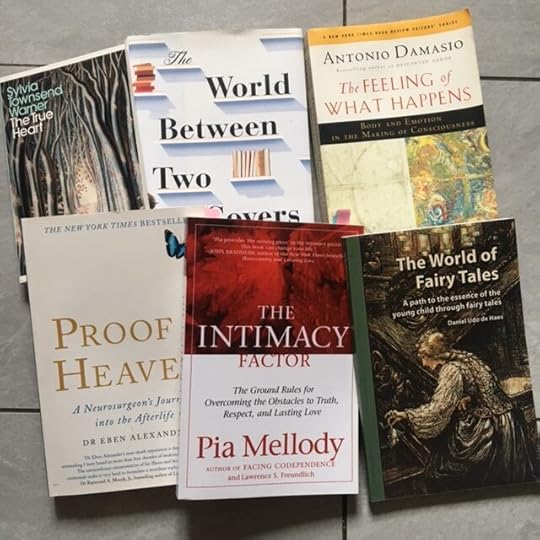
The True Heart by Sylvia Townsend Warner – this was thanks to A Gallimaufry and a STW reading week giveaway Warner is a wonderful writer and I love the sound of this novel, but I still have not gotten around to it.
A Year of Reading the World by Ann Morgan – And this is thanks to Emma of Words and Peace and her 10 year blogoversary giveaway. If it was one of Emma’s favorite books from her years of blogging, I’m sure it’s terrific.
The Feeling of What Happens by Antonio Damasio, Proof of Heaven by Eben Alexander, and The Intimacy Factor by Pia Mellody – these three were picked up at the free book booth I frequent when I’m in the town of Biel. All are nonfiction about psychological topics that interest me.
The World of Fairy Tales by Daniel Udo de Hayes – I worked on editing the translation of another book by this author and I offered to review this one, then I never got to it for unknown reasons. I love fairy tales and I’m sure it’s fascinating. I should really read it and finally give it a proper review!
Which would you choose? You can tell me your thoughts in the comments about more than one book, but in the poll you have to choose one. (Otherwise it gets too confusing.)
March 3, 2024
Month in Review: February 2024
I started adding star ratings to my StoryGraph reviews, but I’m not sure about this practice. My feelings about books are often mixed; I might give 5 stars to one aspect but but 1 star to another, and all the possibilities in between. What about the books that I can tell are well-written, but just aren’t to my personal taste? Nonfiction is difficult to rate because I’d want to rate content and artistry separately. A truly outstanding nonfiction book is a work of art, but there’s nothing really wrong with the more pedestrian kind. And another disjunction is between the emotional impact a book has on me, and my objective assessment of its quality. Sometimes I love books that I can see are quite flawed, for reasons that are hard to define or quantify. Some of my childhood favorites fall into this category, but also quite a lot of books I’m reading now.
Here’s what ratings mean to me: 1 star, not recommended at all (I seldom finish these); 2 stars, worth reading but with serious drawbacks; 3 stars, fine but not exceptional; 4 stars, an excellent read that I recommend highly; 5 stars, outstanding, perfect or nearly so, a favorite I’d reread or have reread multiple times.
So I’ve tried to apply these to the books I read in January and February, but began fiddling with half and quarter stars and ended up dissatisfied with the results. I wish StoryGraph would allow readers to rate different aspects of books – that could be interesting and useful!
Have you read any of these? How would you rate them?
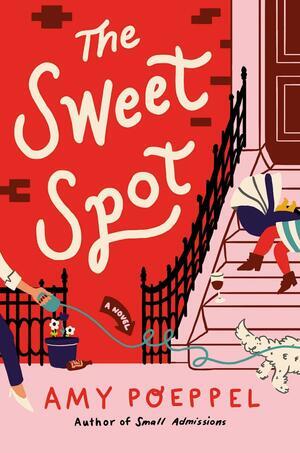 The Collected Schizophrenias by Esme Weijun Wang – Nonfiction Reader Challenge, Health category
The Emotionally Absent Mother
by Jasmin Lee Cori
I Thought We’d Never Speak Again
by Laura Davis
Circle of Hope
by Eliza Griswold – Nonfiction Reader Challenge, a book published in 2024
Emil und die Detektive
by Erich Kästner
Theater Shoes
by Noel Streatfeild – Reread
Anatomy of an Epidemic
by Robert Whitacker
Dorothy and the Wizard in Oz
by L. Frank Baum – Ozathon
The Sweet Spot
by Amy PoeppelLanguage
The Collected Schizophrenias by Esme Weijun Wang – Nonfiction Reader Challenge, Health category
The Emotionally Absent Mother
by Jasmin Lee Cori
I Thought We’d Never Speak Again
by Laura Davis
Circle of Hope
by Eliza Griswold – Nonfiction Reader Challenge, a book published in 2024
Emil und die Detektive
by Erich Kästner
Theater Shoes
by Noel Streatfeild – Reread
Anatomy of an Epidemic
by Robert Whitacker
Dorothy and the Wizard in Oz
by L. Frank Baum – Ozathon
The Sweet Spot
by Amy PoeppelLanguageI finished Emil und die Detektive! I’m now reading Jim Knopf und Lukas der Lokomotivführer, which was gifted to us years ago, and am impressed that I’m able to decipher it without too much difficulty — looking up the occasional word, rather than every other as it seems I had to do not that long ago. Amazing, I must have made progress in five years.
The story is silly, the adoption of a black baby by white characters giving it an uncomfortable start, and the portrayal of China in the early chapters is horribly sterotypical — the book was originally published in 1960, and it shows. But on doing a bit of internet research I was surprised to find that Ende wrote it as an ANTI-racist fable, aimed against the Nazis. (There is one sentence in which Ende says that people are easily confused and think they need a Führer, which when translated as “train conductor” loses its pointed double meaning.)
This is one book that will be decidedly mixed and difficult to rate, but I’ll just try to enjoy the journey for now.
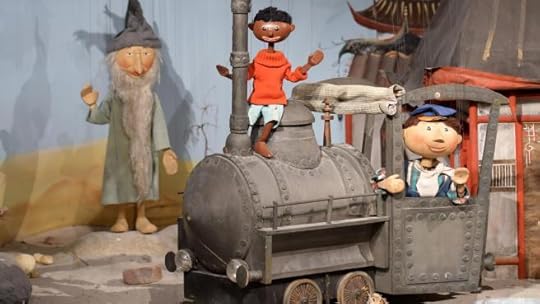 Jim Knopf production by Augsburger PuppenkisteLife
Jim Knopf production by Augsburger PuppenkisteLifeMy great life landmark this month was the publication of my book, When Fragments Make a Whole. The link is to my post that gives ordering information; now I’ll just have to let go and see what happens. If you do read the book, thank you — I hope you’ll let me know what you think.
Here is one release-day review from Bookish Beck, who called it “a calm, honest, methodical book that will intrigue anyone interested in thinking through how the Bible is applicable to the challenges of daily life.” I hope it will land well with other readers, too.
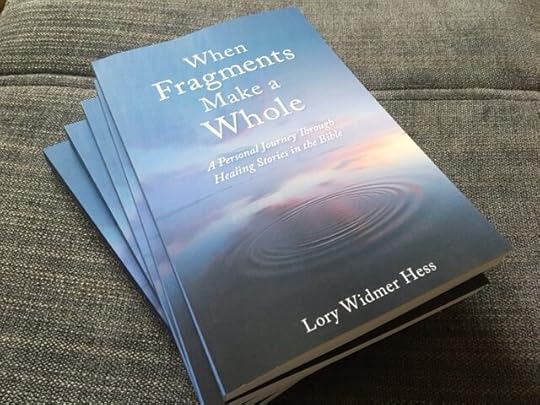
Linked at The Sunday Post at Caffeinated Book Reviewer, the Sunday Salon at Readerbuzz, and the Monthly Wrap-up Round-up at Feed Your Fiction Addiction
February 29, 2024
My book birthday! When Fragments Make a Whole is now available
Dear friends, I’m excited to announce that my book, When Fragments Make a Whole: A Personal Journey Through Healing Stories in the Bible is now available from Floris Books.
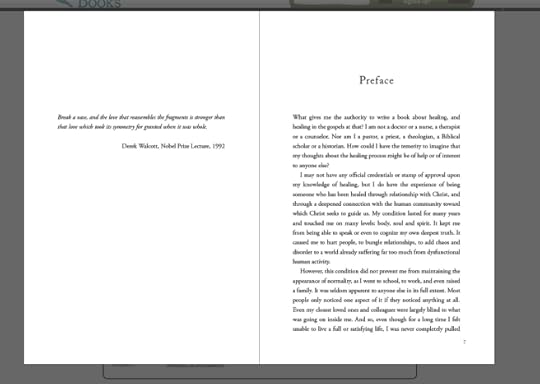
If you’d like to see a preview, click on “See inside” from the Floris book page. You’ll get a pop-up with a generous portion including the introduction and most of the first chapter. You can also read a shorter snippet on the Floris blog.
 Some advance reviews:
Some advance reviews:Offers encouragement to readers to find, ever and again, the steps toward meeting their own wounds and struggles.
—Signe Schaefer, author of Why on Earth? and She Was Always There
A treasure of a book in that it contains accessible explanations of deep spiritual knowledge out of anthroposophy, artistic and personal poetry that move the heart, and the testimony of a life lived by one who has earnestly taken up the path of discipleship.
—Rev. Anna Silber, Christian Community priest in Chestnut Ridge, NY
A book for your own journey, but it is especially a book to catapult you into standing in and with the world-healing that is our task.
—Kathryn Booth, The Alcyon Center
I am so grateful for these wonderful words, and my greatest hope is that the book can indeed be helpful for seekers of healing and grace.
Now, how can I order this amazing book, you ask? There are many options: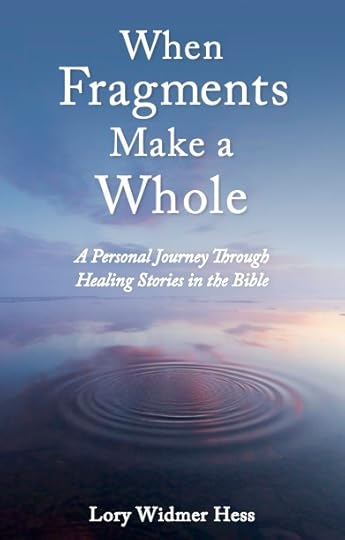 If you’re in the UK, you can order from uk.bookshop.org and benefit local bookshops!If you’re in another country, you can order from Blackwell’s, with shipping included to most countries.And here you can order the Kindle version.You can also pre-order now from bookshop.org in the US for April (when copies will be available from the US distributor). Here is a Bookshop list I created that includes related reading.
UK version
|
US version
All of the above are affiliate links that earn me a small commission.E-book retailers include
Barnes and Noble
and
Kobo
.
If you’re in the UK, you can order from uk.bookshop.org and benefit local bookshops!If you’re in another country, you can order from Blackwell’s, with shipping included to most countries.And here you can order the Kindle version.You can also pre-order now from bookshop.org in the US for April (when copies will be available from the US distributor). Here is a Bookshop list I created that includes related reading.
UK version
|
US version
All of the above are affiliate links that earn me a small commission.E-book retailers include
Barnes and Noble
and
Kobo
.If you do read the book, I will also be very grateful if you will consider leaving a review on Goodreads, Amazon, StoryGraph, or wherever you post your thoughts. I’d love to hear from readers, so feel free to let me know what you think. The ripples will continue to spread…
February 25, 2024
#Ozathon24: February Wrap-up
As the end of the month approaches, this is your chance to share any posts on this month’s book, Ozma of Oz. Add your link in the comments and I’ll gather them here.
So far, here’s what I have collected:
Entering the Enchanted CastlePuss RebootsFor next month’s book, Dorothy and the Wizard in Oz, please visit The Book Stop for the introduction and wrap-up posts. See you there for our next Oz adventure!
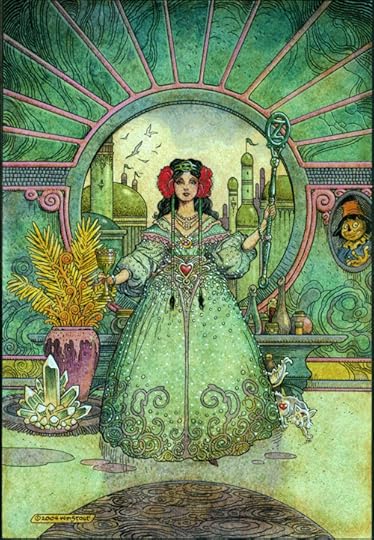 Portrait of Ozma, the ruler of Oz, by William Stout
Portrait of Ozma, the ruler of Oz, by William Stout
February 18, 2024
#Ozathon24: Bringing the Sun Underground
The third book of the Oz series starts with a storm at sea, seemingly far away from Dorothy (who lives in Kansas) and from Oz (which is surrounded by deserts). But we soon learn that Dorothy is journeying on a ship with her uncle Henry, whose health has been broken down by the hardships of farming.
Dorothy was brought back because readers wanted to know what happened to her and to have her meet Ozma, the restored ruler who was introduced in The Land of Oz. From now on, Dorothy will be firmly established as a central character, often the one who goes on journeys and has adventures.
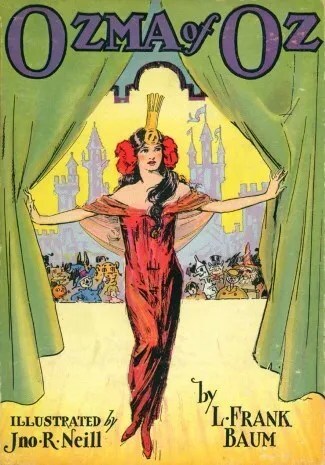 The strangely slinky Ozma in John R. Neill’s cover illustration (usually she’s drawn as a young girl)
The strangely slinky Ozma in John R. Neill’s cover illustration (usually she’s drawn as a young girl)And as she confronts the storm, Baum uses it to show that an ordinary American girl can have some remarkable qualities of her own. When she goes up on deck in search of her Uncle Henry, she feels no fear, only a “sort of joyous excitement in defying the storm.” The wind, “as if enraged because the little girl dared to resist its power,” blows away the chicken coop to which Dorothy is clinging. And thus she is transported, not to Oz, but to the neighboring land of Ev, where she will continue to fight adversarial forces to save and protect others.
Along with the coop comes a new companion, a yellow hen called Bill; apparently when she was named, it was thought she was a rooster. Dorothy re-names her Billina, but Billina remains a fierce fighter who resists overbearing powers, and is not shy about using intelligence and daring to reach her goals. (Dorothy, who seems to prefer gender lines to be more conventionally drawn, scolds her for fighting and using slang, but she remains unrepentant.)
Billina’s move from male to female is reminiscent of that of Ozma, another character who started life with people thinking she was a boy. While I think it’s a mistake to read too much into this as a conscious subversion of binary concepts of gender, it’s clear that Baum finds inner qualities more important than outer markers of identity. People have different abilities, both inborn and acquired; what is most important is for each individual to know themselves thoroughly, and to use their unique abilities in a moral way, in order to help others rather than dominating or enslaving them. Labels are just for convenience. As Billina says, “It doesn’t matter at all what you call me, so long as I know the name means me.”
The Land of Ev, like all fantasylands, is one where moral quandaries take on picture form. Dorothy and Billina very soon encounter these in the form of the Wheelers, whose belligerence masks their cowardice and weakness, and Princess Langwidere, who embodies indolence and vanity. But they also acquire a formidable new helper in the form of Tik-tok, the mechanical man.
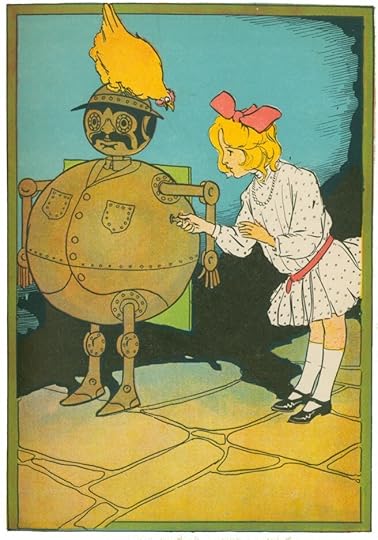 Neill’s illustration of Dorothy winding Tik-tok
Neill’s illustration of Dorothy winding Tik-tokSo far in the series, there have been a number of characters brought to life from inanimate form (notably the Scarecrow and the Sawhorse), as well as the Tin Woodman, a person whose body was replaced by metal, but now we encounter a purely mechanized person. Baum was fascinated by gadgetry and technology, by the rise of the science that now is confronting us with the challenge of artificial intelligence. Reflecting Baum’s optimism about scientific progress, Tik-tok is a benign character, who serves Dorothy faithfully and well. But though he can act, speak, and think, he has no inner life, and thus no morality. He can only play out the program he’s been given, including any mistakes in it (and one of those mistakes leads to dire consequences later.)
Nevertheless, Billina and Dorothy are fortunate to meet him, as he does his best to defend them from threats, until his machinery runs down. Just as Dorothy is imprisoned, another stroke of fortune comes with the arrival of Ozma, who wants to rescue the royal family of Ev from their own imprisonment by the neighboring Nome King. She sets Dorothy free and the two groups join forces for the rescue mission.
Dorothy and Billina prove to be vital to that adventure in a number of ways. The Nome King won’t let Ozma in when she commands him as a fellow monarch, but opens his realm when Dorothy pleads for entry. With her simple, unpretentious nature, Dorothy brings a necessary balance to Ozma’s royal dignity; she also remains the brave girl from the storm-tossed ship, whose quick thinking and action later rescue the group from the power of the underground monarch. Billina, meanwhile, succeeds in defying the Nome King’s tricks where the others have failed. And her daily habit of laying an egg is another simple, unpretentious reminder of the farm back home that ends up being more powerful than anyone would have dreamed.
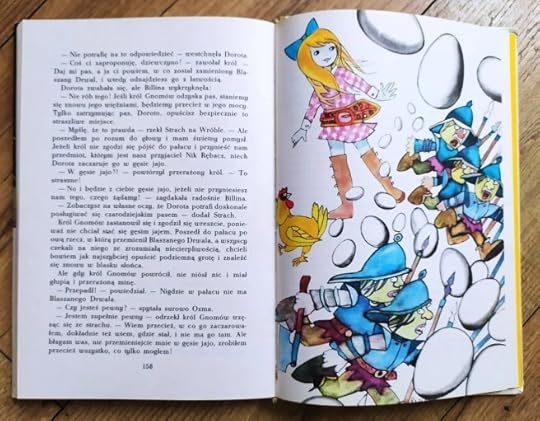 Illustration by Zbigniew Rychlicki
Illustration by Zbigniew RychlickiAn egg is a sun symbol, and Billina is significantly a yellow hen — the only one in her whole flock. Together, the crafty Billina and the guileless Dorothy bring light into the dark, underground realm of the Nomes. The Nome King is a master of deception, turning things into what they are not; salvation comes through innocence and canniness joining forces to resist the power of evil. The journey underground has been another moral challenge, a sun-hero’s journey that, as often happens in the Oz books, is completed not by a single person, but by a group of people with complementary skills.
There’s more to enjoy; Baum’s dry humor is also in evidence, as he pokes fun at food fanaticism (Dorothy finds it disgusting to eat live bugs and Billina to eat dead cows) and at militarism (through Ozma’s army, which consists entirely of officers with one private for them to command). There is a joyful reunion with our old friends the Scarecrow, the Tin Woodman, and the Cowardly Lion, and the introduction to another new character, the Hungry Tiger, who longs to eat fat babies but unfortunately has a conscience that won’t let him — another of Baum’s satirical touches.
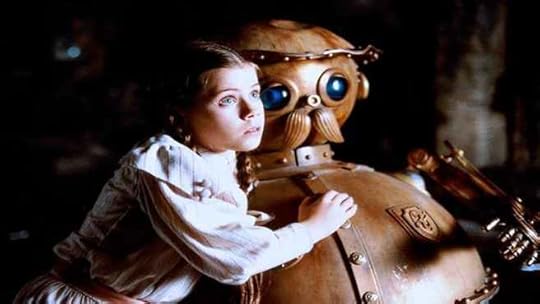 Dorothy (played by Fairuza Balk) and Tik-tok in Return to Oz
Dorothy (played by Fairuza Balk) and Tik-tok in Return to OzIf you’ve seen the movie Return to Oz, you will recognize some of the elements that were woven into that dark and scary film, which begins with Dorothy considered insane for talking about her adventures in Oz. Ozma of Oz is considerably lighter in mood — though Billina shows some initial skepticism when she hears Dorothy talking about Oz, that’s another absurd touch coming from a talking chicken.
Overall, I find Ozma one of the most tightly constructed and artistically satisfying books of the series, every scene a delight of one kind or another. What did you think? I’ll be back at the end of the month with a wrap-up post to gather any other thoughts about the book. Feel free to link them here, or add your responses in the comments.

